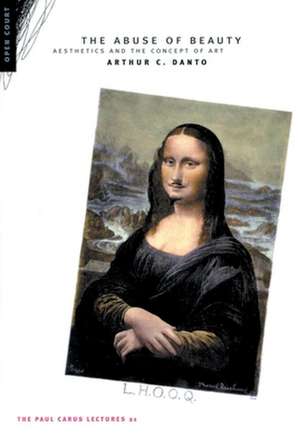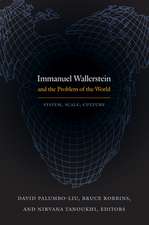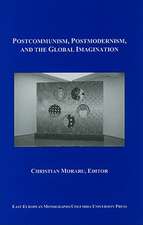The Abuse of Beauty: Aesthetics and the Concept of Art: Paul Carus Lectures, cartea 21
Autor Arthur C. Dantoen Limba Engleză Paperback – 5 iun 2003
Danto simply and entertainingly traces the evolution of the concept of beauty over the past century and explores how it was removed from the definition of art. Beauty then came to be regarded as a serious aesthetic crime, whereas a hundred years ago it was almost unanimously considered the supreme purpose of art. Beauty is not, and should not be, the be-all and end-all of art, but it has an important place, and is not something to be avoided.
Danto draws eruditely upon the thoughts of artists and critics such as Rimbaud, Fry, Matisse, the Dadaists, Duchamp, and Greenberg, as well as on that of philosophers like Hume, Kant, and Hegel. Danto agrees with the dethroning of beauty as the essence of art, and maintains with telling examples that most art is not, in fact, beautiful. He argues, however, for the partial rehabilitation of beauty and the removal of any critical taboo against beauty. Beauty is one among the many modes through which thoughts are presented to human sensibility in art: disgust, horror, sublimity, and sexuality being among other such modes.
Danto draws eruditely upon the thoughts of artists and critics such as Rimbaud, Fry, Matisse, the Dadaists, Duchamp, and Greenberg, as well as on that of philosophers like Hume, Kant, and Hegel. Danto agrees with the dethroning of beauty as the essence of art, and maintains with telling examples that most art is not, in fact, beautiful. He argues, however, for the partial rehabilitation of beauty and the removal of any critical taboo against beauty. Beauty is one among the many modes through which thoughts are presented to human sensibility in art: disgust, horror, sublimity, and sexuality being among other such modes.
Preț: 121.63 lei
Nou
Puncte Express: 182
Preț estimativ în valută:
23.28€ • 24.21$ • 19.22£
23.28€ • 24.21$ • 19.22£
Carte disponibilă
Livrare economică 24 martie-07 aprilie
Livrare express 07-13 martie pentru 23.10 lei
Preluare comenzi: 021 569.72.76
Specificații
ISBN-13: 9780812695403
ISBN-10: 0812695402
Pagini: 224
Ilustrații: Illustrations (some col.)
Dimensiuni: 154 x 209 x 12 mm
Greutate: 0.32 kg
Ediția:21.
Editura: Open Court
Seria Paul Carus Lectures
Locul publicării:United States
ISBN-10: 0812695402
Pagini: 224
Ilustrații: Illustrations (some col.)
Dimensiuni: 154 x 209 x 12 mm
Greutate: 0.32 kg
Ediția:21.
Editura: Open Court
Seria Paul Carus Lectures
Locul publicării:United States
Notă biografică
Arthur C. Danto is Johnsonian Professor of Philosophy Emeritus at Columbia University. He is the art critic for The Nation and author of more than 20 books.
Descriere
In The Abuse of Beauty, art critic and philosopher Arthur Danto explains how the notion of beauty as anathema to art arose and flourished and offers a new way of looking at art and beauty. He draws on the thought of artists, critics, and philosophers such as Rimbaud, Fry, Matisse, and Greenberg, to reposition beauty as one of many modes — along with sexuality, sublimity, disgust, and horror — through which the human sensibility expresses itself. 20 black-and-white illustrations are included.




























